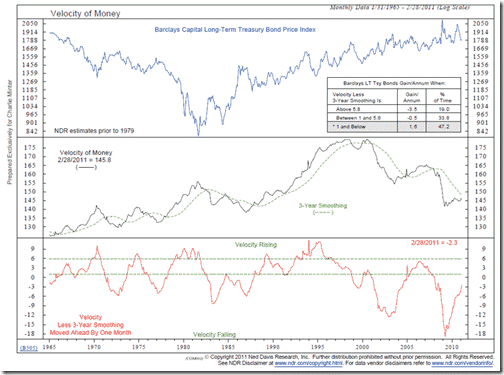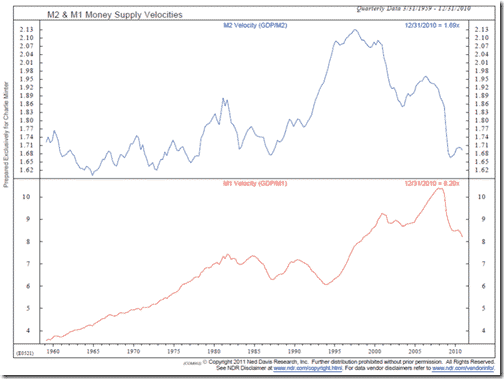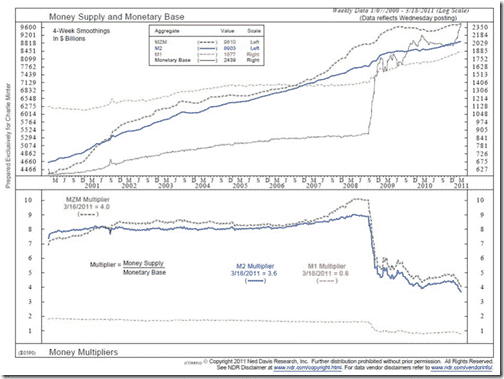Debt Problem Grave, But Solution Elusive
By Comstock Partners
The massive U.S. debt problem that we have been discussing so often for many years has now become widely known both to investors and the general public. It has been a major topic of discussion in the media as well as a key issue in last November’s elections. To take just one recent example, Gregg Fleming, the head of Morgan Stanley, Smith Barney, stated on CNBC that the total debt ( including government, individual, corporate, and financial institutions) in the U.S. has increased by over $40 trillion since 1984 ($11 tn to $52.4 tn). He stated that, in his opinion, the unusually sluggish recovery we are now experiencing is a result of the deleveraging of this debt. Furthermore, he did not even mention the "impossible to keep" promises that have been made by our federal government for entitlements, and by state and local governments’ for health care and pensions. If these were included it would increase this country’s total obligations to over $150 trillion.
What Mr. Fleming implied, but didn’t say is that the private side of this debt has to be liquidated or defaulted on before a sustained organic recovery is possible. It is fortunate that the topic of excess debt has come to the forefront and that the situation has come to the attention of the general public. What is lacking, however, is any agreement on what to do, as there is no satisfactory solution in sight. So far, massive stimulation through fiscal and monetary policy has substituted in part for the lack of consumer spending, but this cannot continue for long without putting the federal government’s financial status at risk. Yet if government spending is substantially cut back while the economy is still so fragile another serious recession can ensue. This dilemma has created serious divisions between the two major political parties and the public in general.
Although many people believe that we will be able grow our way out of this enormous debt problem, a number of the more savvy pundits understand how much money we are throwing at the problem, and are convinced that this will lead to a significant inflation, if not hyper-inflation. Economists and strategists that believe we will grow our way out of this debt problem naturally are very bullish on the U.S. stock market. In addition, the majority of the inflationists also believe that the aggressively easy monetary and fiscal policies will drive the stock market much higher, although not by enough to offset a resulting weaker dollar. This is probably why the sentiment figures are now showing mostly bulls, while margin debt is back to the prior highs of 2007-2008. Most of our readers understand that these "bullish" sentiment readings are a contrary indicator and therefore very negative for the stock market.
Our feeling, as long-time readers will not be surprised to hear, is that this enormous debt will not be inflationary but deflationary instead. If this is the case, the stock market is headed much lower and the economy will either go into a double-dip or have such a sluggish recovery that it will feel like one. There are the two main reasons we are so convinced that we will not be able to inflate or grow our way out of this mess. First, the massive increase that QE1 and QE2 has generated in the monetary base has not been translated into anywhere near a commensurate rise in money supply (the so-called "money multiplier"). Second, the subdued rise in the money supply to date has not resulted in a big increase in GDP (the so-called "velocity of money")–see attachments.
In addition, the loose fiscal policies cannot generate the borrowing and spending that is required to get the money supply up enough to drive the economy and inflation higher. The velocity of money is also influenced by interest rates. When rates are low, people hold more money in cash. On the other hand, when rates are rising, they put more money in interest paying investments. The low rates, as we have now, results in a "liquidity trap", which is what Japan has also experienced over the past 21 years.
Unless we escape this "trap" there will be massive deleveraging by the sector that drove us into this mess. Household debt rose from 50% of GDP in the 1960s, 70s and 80s and eventually doubled to close to 100% of GDP presently. This debt will either be defaulted on, or paid down until we get back to the norm of around 50% of GDP again. This will bring household debt down below $10 trillion from $13.5 trillion now.
Another reason that makes us so convinced that the "debt situation" will be resolved by deflation and not inflation is the political environment that is currently sweeping the nation. The Republicans and Tea Party congressmen and governors that were recently elected ran on a platform of cutting government expenditures, cutting back on entitlement expenditures, and doing whatever possible to pay down the debt. In fact, the bipartisan "Debt Commission" that was sponsored by President Obama, came up with a number of austerity measures that would cut the deficit substantially over time. The big problem, however, is that any austerity program implemented now will only exacerbate the ongoing deleveraging of this debt and throw the economy into recession.
There are two more reasons that we believe the onerous debt incurred over the past 30 years will wind up with a painful deflationary bear market rather than inflation or hyper-inflation. First, the high cost of necessities such as food and energy is much more deflationary than inflationary. Since wages have been static for years, the high cost of these necessities acts to reduce real disposable income. This, in turn, reduces what the average consumer can purchase with his or her disposable income. More money spent on energy and food simply means less money to spend elsewhere. In order for easy fiscal and monetary policy to result in significant inflation there must be a transfer mechanism, and that mechanism is a rise in wages by an amount at least enough to enable consumers to pay the higher prices. That just doesn’t look as if it is going to happen.
The last reason is the slack in the economy. The capacity utilization is just 76.3% as of the end of February, and with that much overcapacity it is hard to generate large price increases. It is hard to have much inflation when there is that much slack in both the economy and the labor market.
We also point out that Japan has run an easy monetary policy and large fiscal deficits for 21 years. These were virtually the same type of policies that the inflationists here claim will cause severe inflation in the U.S. Yet this never came about since Japan was affected by the same "liquidity trap" that we are in presently and will probably remain in for many more years to come.
To summarize, the debt situation has become well known and understood throughout the nation. Many can now articulate the problems that go along with our government’s borrowing over 40 cents for every dollar we spend. They can explain that "no household can get away with borrowing 40 cents out of each dollar spent, so why should our government be able to do it without repercussions?" They also now understand that our total debt and "impossible to keep" promises to our population are out of control and are presently over 10 times our GDP. It is fortunate that these problems are better understood. But, the public’s view of the resolutions (grow the economy and/or inflate), will be much more difficult than they think as long as "velocity" remains low. Although we believe the eventual result will be deflationary, we still put only about a 65% probability on that outcome, a 30% probability of an inflationary outcome, and only about a 5% chance of being able to grow our way out of the problem.



Either a deflationary or inflationary outcome is bad. So in reality there is a 95% chance of serious social unrest in the US as a result of economic policies. That 5% chance of it turning out well seems slim and bordering on the odds that a desperate gambler will chance to get him out of his mess. So neo-classical economics is really just gambling.
The real problem of a slow deflationary outcome is that it gives incentives to some to lobby for measures that are in their interests and against everyone else’s. If we had had that rapid collapse that wiped out the banks and speculation it would have mean that the government would have had the funds to stimulate the economy. Now all that will happen is that the US will have another stagnant twenty years as debts are paid off and those with money move it offshore to get real returns. Austerity will punish the working and middle classes yet many have no idea that they will have a lost generation to come.
Either a deflationary or inflationary outcome is bad. So in reality there is a 95% chance of serious social unrest in the US as a result of economic policies. That 5% chance of it turning out well seems slim and bordering on the odds that a desperate gambler will chance to get him out of his mess. So neo-classical economics is really just gambling.
The real problem of a slow deflationary outcome is that it gives incentives to some to lobby for measures that are in their interests and against everyone else’s. If we had had that rapid collapse that wiped out the banks and speculation it would have mean that the government would have had the funds to stimulate the economy. Now all that will happen is that the US will have another stagnant twenty years as debts are paid off and those with money move it offshore to get real returns. Austerity will punish the working and middle classes yet many have no idea that they will have a lost generation to come.